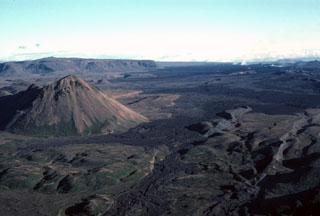Report on Krafla (Iceland) — September 1978
Scientific Event Alert Network Bulletin, vol. 3, no. 9 (September 1978)
Managing Editor: David Squires.
Krafla (Iceland) Inflation slows and becomes irregular; new deflation expected in a few weeks
Please cite this report as:
Global Volcanism Program, 1978. Report on Krafla (Iceland) (Squires, D., ed.). Scientific Event Alert Network Bulletin, 3:9. Smithsonian Institution. https://doi.org/10.5479/si.GVP.SEAN197809-373080
Krafla
Iceland
65.715°N, 16.728°W; summit elev. 800 m
All times are local (unless otherwise noted)
"Since the end of the deflation event of 10-13 July, inflation within Krafla caldera has continued at a similar rate as before. The rate of inflation as recorded on the tiltmeters was very uniform until about 20 September. Since then the inflation has been slower and more irregular. Similar irregularities have generally been observed a few weeks before previous deflation events. It is expected that the land elevation will reach the previous level about the second week of October. After that, a deflation event can be expected within a few weeks.
"Where the magma will go this time is more uncertain. Very significant rifting has now taken place on most parts of the fault swarm N of Krafla and on the S part next to the caldera. Recent predictions have therefore emphasized the possibility of a rifting event in the southernmost part of the fault swarm. However, the possibility of another rifting event to the N, or an eruption, can in no way be excluded."
Geological Summary. The Krafla volcanic system in the Northern Volcanic Zone (NVZ) of Iceland is about 100 km long, consisting of a fissure swarm and a central volcano with a 7 x 9 km caldera formed about 110,000 years ago that deposited a rhyolitic welded tuff. It has been moderately active in the Holocene, over three distinct eruptive periods; the current one has lasted about 2,800 years with six volcano-tectonic episodes, each with one or more basaltic fissure eruptions. Lava volumes (DRE) have been in the 0.1-1 km3 range. The Hverfjall and Ludent tuff rings east of Myvatn were erupted along the fissure system. Myvatn lake formed during the eruption of the older Laxarhraun lava flow from the Ketildyngja shield volcano of the Fremrinamur volcanic system about 3,800 years before present (BP); The present Myvatn lake is constrained by the roughly 2,000 years BP younger Laxarhraun lava flow from the Krafla volcanic system. The abundant pseudocraters that form a prominent part of the Myvatn landscape were created when the younger Laxarhraun lava flow entered the lake. The last eruption took place in 1975-1984 CE when nine small basaltic fissure eruptions produced 0.25 km3 of lava.
Information Contacts: K. Grönvold, NVI.

